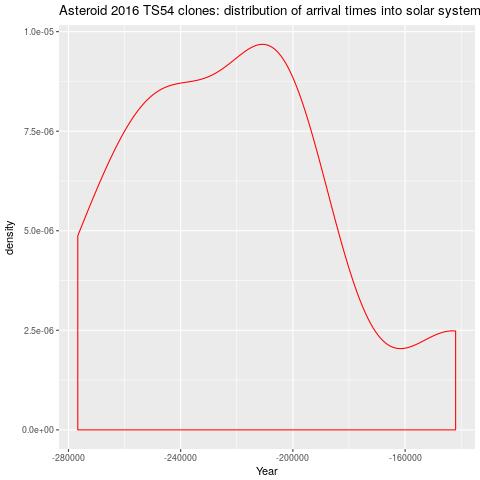===========================================
Original post:
This is an Apollo asteroid and a NEO.
The orbit uncertainty is very high (condition code 7).
JPL data:
(2016 TS54)
| Classification: Apollo [NEO] SPK-ID: 3760683 |
| [ Ephemeris | Orbit Diagram | Orbital Elements | Physical Parameters | Close-Approach Data ] |
[ show orbit diagram ]
| Orbital Elements at Epoch 2458000.5 (2017-Sep-04.0) TDB Reference: JPL 3 (heliocentric ecliptic J2000)
| Orbit Determination Parameters
Additional Information
|
Just for fun, I simulated 100 clones of this Apollo asteroid in the past 10^8 days trying to
see if there are signs of a possible cometary origin:
i.e. whether some clones might have arrived from the outskirt of the solar system - threshold: 100 AU.
i.e. whether some clones might have arrived from the outskirt of the solar system - threshold: 100 AU.
Simulation approach
reference:
J.E.Chambers (1999)
A
Hybrid Symplectic Integrator that Permits Close Encounters between
Massive Bodies''. Monthly Notices of the Royal Astronomical Society, vol
304, pp793-799.
Integration parameters----------------------
Algorithm: Bulirsch-Stoer (conservative systems)
Integration start epoch: 2458000.5000000 days
Integration stop epoch: -100000000.0000000
Output interval: 100.000
Output precision: medium
Initial timestep: 0.050 days
Accuracy parameter: 1.0000E-12
Central mass: 1.0000E+00 solar masses
J_2: 0.0000E+00
J_4: 0.0000E+00
J_6: 0.0000E+00
Ejection distance: 1.0000E+02 AU
Radius of central body: 5.0000E-03 AU
Simulation Results
The cometary origin of Asteroid 2016 TS54 is less clear than in other cases where I got a lot of clones with cometary-like orbits.
Anyway, in this case 9 out of 100 clones arrived in the solar system from a distance greater than 100 AU.
I would not be surprised if many more clones would get ejected if the simulation went more back in the past.
> summary(ejected$Year):
Min. 1st Qu. Median Mean 3rd Qu. Max.
-276671 -243932 -219308 -221057 -202058 -141985
This plot shows the distribution time in a graphical way:
One thing that sometimes occurr during these simulations ... many clones that had to be discarded - because they seem to have originated from the sun due to a very high eccentricity:
From file.out of Mercury simulator:
was hit by TS_94 at -35503 11 8.1
was hit by TS_47 at -54568 9 14.4
was hit by TS_98 at -99015 10 20.5
was hit by TS_72 at -99560 2 21.8
was hit by TS_96 at -148788 10 6.0
was hit by TS_91 at -149964 11 28.2
was hit by TS_7 at -156722 2 4.0
was hit by TS_77 at -162338 5 30.9
was hit by TS_73 at -166169 2 21.5
was hit by TS_9 at -168018 11 11.8
was hit by TS_18 at -191284 7 16.3
was hit by TS_48 at -200641 11 13.5
was hit by TS_8 at -207786 9 27.0
was hit by TS_51 at -217189 12 14.4
A curious clone - hyperbolic orbit
What is curious is that one clone (only one!) seems to have entered the solar system following an hyperbolic trajectory.
Day a e i w om
...
...
-99309899.5 -61.47015 1.111092 2.6958 241.4296 241.5559
-99309799.5 -61.48959 1.111059 2.6970 241.4380 241.5471
-99309699.5 -61.41541 1.111200 2.6980 241.4380 241.5401
-99309599.5 -61.29102 1.111422 2.6994 241.4445 241.5318
-99309499.5 -61.07459 1.111812 2.7014 241.4495 241.5226
-99309399.5 -60.62682 1.112621 2.7044 241.4565 241.5127
-99309299.5 -59.72419 1.114282 2.7101 241.4700 241.5018
-99309199.5 -57.25347 1.119078 2.7246 241.5052 241.4958
-99309099.5 -36.49813 1.182189 2.7886 242.9846 241.5639
Then, there was an encounter with Saturn:
Days Planet Dmin a1 e1 i1
-99309089 SATURN 0.02332127 -402.1809 1.013726 0.314
The encounter distance was 0.02 AU, the semi-major axis had a spike ...physically possible or not? (I do not know!) but the clone was then captured in an elliptical orbit:
After the encounter we see:
Day a e i w om
-99308999.5 28.48699 0.812484 1.3768 71.9542 78.5563
-99308899.5 27.76675 0.807261 1.3830 71.9916 78.5274
-99308799.5 27.55270 0.805645 1.3842 71.9835 78.5263
-99308699.5 27.45602 0.804901 1.3846 71.9719 78.5273
-99308599.5 27.40985 0.804531 1.3848 71.9557 78.5286
-99308499.5 27.39724 0.804417 1.3849 71.9409 78.5301
-99308399.5 27.38719 0.804331 1.3850 71.9305 78.5308
-99308299.5 27.39765 0.804393 1.3850 71.9164 78.5324
....
I think this is just a simulation fluke due to the fact that clones "diverge" quite a lot and so some of them seem to have an hyperbolic trajectory.
However, this raises a question: people who are really expert in this field may be able to put some constraint about the
probability of these "unstable" asteroids (or old comets?) being hidden interstellar objects captured a long time ago.
This possibility is related to the question "how rare is a close passage of an interstellar rock to our star?" discussed by Alan Harris in this MPML message.
This analysis would be interesting considering the very recent discovery of the first recognized interstellar object by Robert Weryk on October 19, 2017 with observations made by the Pan-STARRS telescope:
A/2017 U1 = 1I/'Oumuamua (MPEC 2017-V17)
A few nice links about this discovery (impossible to give all ... but I share with you the ones that most impressed me):
- the "early warning" given by Bill Gray, probably the first public mention!
- A deep analysis from Bill Gray that summarizes why the object is with no doubt interstellar (in response to many questions, including mine, on whether there might be alternative explanations).
- images of the objects taken by Paolo Bacci and Martina Maestripieri
- A simulation from Tony Dunn
- look at MPML to see very interesting threads about this object.
Alessandro Odasso

No comments:
Post a Comment
Note: Only a member of this blog may post a comment.